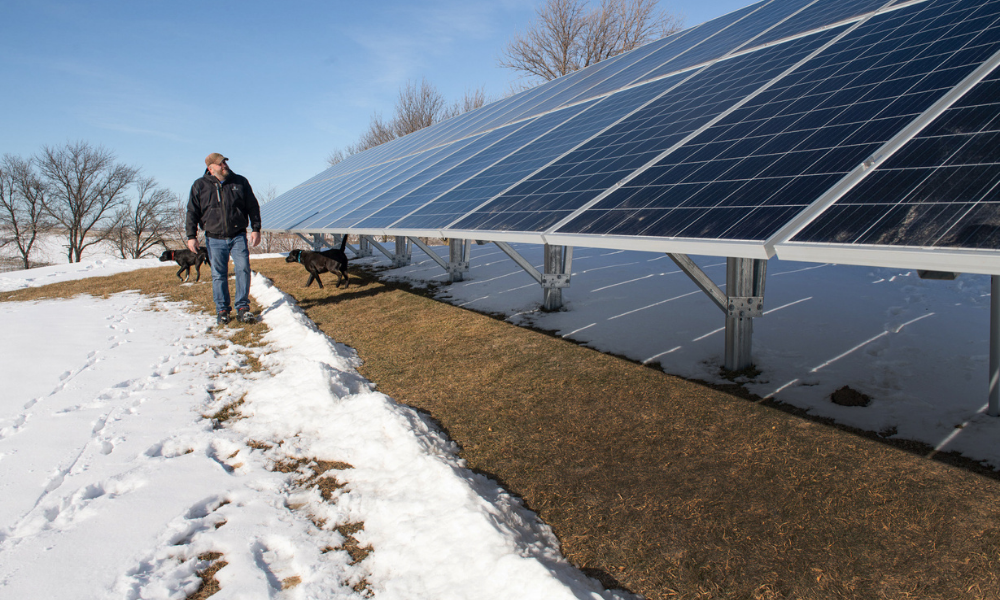
Kevin McGrain inspects his solar panels on his farm near Hornick. (Photo: Joseph L. Murphy/Iowa Soybean Association)
Fitting conservation into profitability
February 15, 2021
When Kevin McGrain started farming no-till in 1996, his neighbors watched from afar, expecting the seemingly crazy practice to fail. But on McGrain’s farm, failure would have looked like doing nothing at all in the face of extreme erosion.
Now, 25 years later, the Hornick-area soybean, corn and cattle farmer reaps the benefits of better soil health, stronger weed control, more dollars and more time. A crucial practice at the backbone of his farm, cover crops and solar panels now add to the sustainability of his row-crop operation.
“I don’t think consumers know how we’ve been improving the ways we farm for decades now,” says McGrain. “The conservation practices we do now would have blown my father’s mind 40 years ago.”
Consumer trends have indicated an increasing desire for product sustainability, from fashion to farming. This eco-driven mindset influences purchasing decisions, according to the Iowa Food & Family Project’s annual Consumer Pulse Survey. 43% of Iowa consumers rated the conservation practices farmers implement as either “somewhat” or “very” important in their grocery shopping decision making.
For Perry-area farmer Tom Vincent, sustainability is a buzzword, but it does the job of getting consumers to think about agriculture.
“If you’re a consumer concerned about greenhouse gases, the no-till farmer has a great story to tell,” says Vincent, who also serves as a director on the Iowa Soybean Association (ISA) board. “We’re growing better crops and sequestering more carbon through better farming practices.”
Many in-field conservation practices McGrain and Vincent employ not only contribute to soil and water health but also pave the way for stronger yields and better profitability.
“I try to be a good steward, but at the end of the day, there has to be a business component to it,” says McGrain. “I have to run my business, and I can’t keep it going if I don’t think about numbers.”
The business of conservation
For the ISA Research Center for Farming Innovation, conservation and profitability go hand in hand.
“As we work with farmers across Iowa, the goal is to always be better and to look for ways to continually improve,” says Todd Sutphin, sr. research program manager who oversees ISA’ field services team. “It’s about advancing overall performance.”
Sutphin and the field services team work to approach farming innovation holistically. He says profitability, agronomy and conservation create well-rounded operations.
This trifecta, Vincent argues, is what defines sustainability.
“The higher yields I can achieve on my land area that is well-suited for production agriculture, then theoretically, the less land that may be considered fragile or provides habitat needs to be put into production to grow the food, fuel and fiber the world needs,” says the central Iowa soybean and corn farmer. “And when farmers are profitable, we can keep going and make investments like bioreactors and other projects to contribute back to the environment long term.”
The Iowa Food & Family Project’s survey shows an additional 51% of Iowa grocery shoppers rate “how food is grown and raised” as an important part of their decision-making. The checkoff-driven ISA research team points out that while in-field conservation practices certainly have a positive impact on soil and water, the edge-of-field and other value-added practices farmers employ contribute back to their farms and overall environment.
Beyond the field
An ISA field services team member says one of his many roles is helping farmers incorporate habitat into their operations.
“Production agriculture has to be attentive to management on multiple fronts, including crop protection products and the risk they carry on species,” says Corey McKinney, ISA field services program manager. “This is why ISA is working on incorporating habitat into operations while maintaining productivity and profitability.”
McKinney works to establish targeted habitat like pollinator plots and restore oxbows, which are c-shaped, off-channel wetlands home to many native Iowa species. This work comes at no cost to farmers. Nearly 30 habitat sites across Iowa have been restored or are in the planning process for work this year.
“Conservation practices are not done all at once,” reminds Sutphin. “I like to look at it as a continuum. It’s our job at ISA to help farmers along that continuum and to know that not all innovation is going to work and not every practice is suited for every farm.”
While consumers push for more sustainable practices in every industry – including agriculture – farmers face the reality that conservation is easier when dollars are available. Programs like the newly established Soil & Water Outcomes Fund – a subsidiary of ISA – pays farmers on a per-acre basis for environmental outcomes related to water quality, soil health and carbon sequestration help.
McGrain’s long-term message to consumers is that he, and most farmers, try to be better every single year.
“I want people to look at my farm and say, ‘That’s the right way to do things’,” he says. “I want them to know my farm is more environmentally friendly than it was a decade ago or even five years ago and that it will only keep getting better.”
This story was originally published in the February 2021 issue of the Iowa Soybean Review.
Back